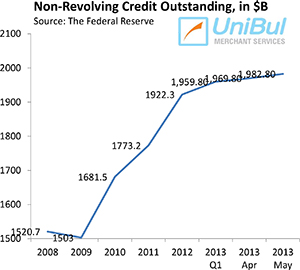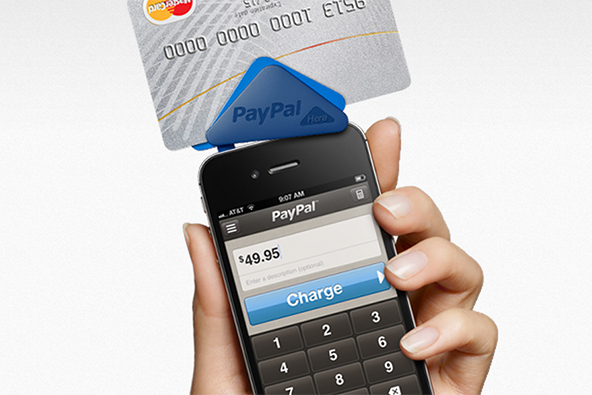Wells Fargo to Test Chip and PIN Credit Cards

Wells Fargo wants to make it easier for U.S. consumers to use their credit cards abroad, we learn from a press release. The San Francisco-based bank is piloting the “Visa Smart Card” — an EMV (better known in Europe as chip and PIN) type of card. The test program will involve 15,000 globe-trotting Wells Fargo consumer credit card customers.
What Is EMV?
Chip and PIN credit cards look much as the ones we Americans already have in our wallets. The difference is that the account information is stored in a microchip (about 3 x 5 mm in size) embedded in the card, instead of in the magnetic stripe located on its back.
When a cardholder wants to make a payment using an EMV type of card, she would insert the card into the point-of-sale (POS) terminal, which would “read” the information stored in the chip and ask for a 4-digit PIN. Once the cardholder enters the PIN, it is matched to the one in the chip and the result is displayed on the terminal screen.
So from a cardholder’s point of view, an EMV transaction feels very much like a PIN-based debit one. Another similarity, the technology’s proponents claim, is that both types are much more secure payment forms than signature-based cards.
Why Is Wells Fargo Launching this Pilot?
 Americans have been finding it increasingly difficult to use their credit cards when traveling in Europe and elsewhere and the main reason for that is the spread of the chip and PIN technology. EMV-enabled terminals are typically not equipped to read magnetic stripes.
Americans have been finding it increasingly difficult to use their credit cards when traveling in Europe and elsewhere and the main reason for that is the spread of the chip and PIN technology. EMV-enabled terminals are typically not equipped to read magnetic stripes.
What makes matters even worse is the human element, as many Americans have discovered. European sales clerks are so used to chip-and-PIN types of cards that they often just don’t know what to do with signature-based ones, even if the equipment supports them. “You have to argue with them to use the card,” is how one traveler described his experience.
With credit cards out of the picture, traveling Americans have been forced to rely mostly on cash and ATM cards (which are supported almost universally) and these options have their disadvantages too. For one, we are not used to carrying much cash on ourselves, nor is it a good idea to do so. And the drawback of using ATMs abroad is that it can be very costly. For example, Wells Fargo charges a flat $5 withdrawal fee on all foreign transactions, which is on top of whatever the ATM operator charges. Other U.S. banks charge a percentage-based currency conversion fee, in addition to a flat fee. For example, Chase charges $3 plus 3 percent currency conversion fee for regular accounts and $0 plus 3 percent currency conversion fee for premium accounts.
Credit Card Takeaway
So Wells Fargo has decided to start issuing credit cards that can actually work abroad and I think that this is a good thing. It would be even better if we had a single universal standard, so that we don’t have to think of such issues, but that is more in the realm of wishful thinking.
Hopefully Wells Fargo will also do something about the 3 percent currency conversion fee it charges on all foreign credit card transactions. The only major U.S. issuer that does not charge such a fee is Capital One.
Image credit: Wikimedia Commons.



I wonder where these ‘many Americans’ experienced difficulties paying by signature based cards, because I have been travelling trouhout Europe for many years with my swipe only Visa, and never had any problems. Sometimes in the UK cashiers were suprised, but it always worked out just fine. All POS terminals in Europe support swipe transactions, the only thing is that some terminals facing the customers at checkout only has a slot for EMV cards, now that is confusing, but the fact is, that it is only a part of the POS unit and if you hand your card to the cashier he or she will be able to swipe it!
Just think about it: if they display Visa/MC logo, they must be able to accept both swipe and EMV cards!
Personally I still prefer swipe and sign, but Europe is changing over to chip and PIN cards. In most countries banks are no longer allowed to issue cards without a chip.
Read today’s blog for details. It refers to some statistics that will answer your questions.
In May, I was overseas and had numerous challenges because I did not have a chip and pin card. The biggest challenges occurred in Copenhagen, Denmark. There were a few places where the merchant were able to override the system to print a receipt and have me sign. However, most merchants refused and I am not quite sure if they really couldn’t OR didn’t want too. One friendly merchant that was able to override it explained that if they print the receipt and have us sign… then the merchant will have to make a trip to the bank to deposit the signed slip. With the chip and pin technology, the pin is basically the customers signature and everything is handled electronically without a trip to the bank. In my experiences, I believe that most of the merchants at the register where unaware of how to override the system to print a receipt.
It is possible that some merchants overseas just don’t know how to handle mag-stripe cards, but also some of them may have a policy against accepting mag-stripe cards, for whatever reason. In any case, it is an issue that Americans will have to deal with for some time to come.
We have just returned from extensive travel in Europe. In UK post offices and many smaller restaurants, among other places, would not accept non-chipped and pinned cards. One restauranter explained that the American cards are not considered ‘safe’ as they can so easily have their info. stolen and the restaurant has had so much trouble that they just decline the cards. We also had problems in Germany. I bought a Travelex card in the airport and had no trouble at all with that. I hope that the Wells Fargo cards become generally available to customers – soon!
Yes, using mag-stripe cards in Europe is becoming increasingly difficult, although I think the Europeans are overplaying the security issue. Still, let’s hope that we will soon get credit cards we can use on both sides of the Atlantic.
We are stationed in Europe and I was rejected several times using my swipe card this week. Starting 2012 they will no longer authorize you to use the swipe device. I use to have an account with Wells Fargo, but made the switch over to AFC for the convenience (?) to find out they only carry the chip in Credit Cards and not VISA/Debit cards. I guess we have to go back to the old days, carry lots of cash on you and hope and pray we don’t get robbed!!!
Yes, I know from personal experience how inconvenient not being able to use your card could be. You may want to look at other options. Both Chase and Wells Fargo now offer chip-and PIN credit cards, which are specifically designed for use overseas, but can also be used in the U.S. At least one of them – the Chase / British Airways card – charges no foreign transaction fees, so using it in Europe would be very much as using it at home.
I do not know why in USA credit card companies do not gives the PIN for the credit card. It is more secure for customer to shop and even if it is lost or stolen PIN is added security. when i asked Banks about this matter, they said that we do not have to worry about fraud because companies offer zero liability to customers. But isn’t the PIN is more secure for banks also. I do not know why it is possible for debit card and not possible for credit card.
Gen,
The reason U.S. banks have not yet switched to chip-and-PIN cards is that the conversion would have cost them billions of dollars, so they’ve been happy to just accept the higher fraud losses associated with magnetic-stripe-based cards. For a more detailed analysis, read this post: http://blog.unibulmerchantservices.com/outdated-mag-stripe-technology-helps-credit-card-fraudsters. However, that is all about to change quickly, because Visa has made it mandatory for all U.S. processors to support acceptance of chip-based transactions by April 1, 2013. Read more about that here: http://blog.unibulmerchantservices.com/nfc-ascent-pushes-visa-to-speed-up-adoption-of-smart-credit-cards.
As of today, we are much closer to EMV adoption. By April of next year, all US processors will support acceptance of chip cards, so our European headaches will be cured.